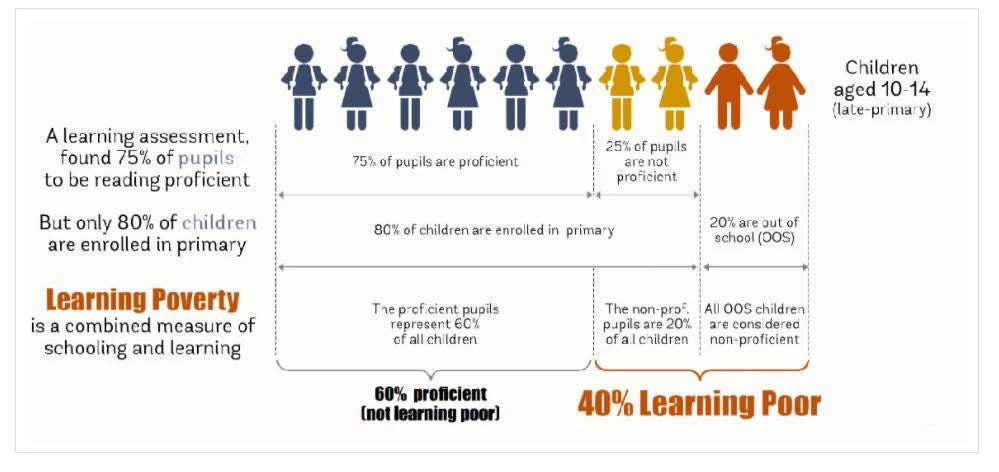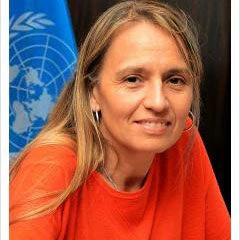
Most governments and development partners are working on identifying, protecting, and supporting learning of the most vulnerable members of the COVID-19 generation. In this blog, we examine how the SDG 4.1.1 framework and the concept of learning poverty are well positioned to help countries understand and act on the impacts of COVID-19 on schooling and learning.
From the minimum proficiency level to a measure of learning deprivation
In October 2018, the international community agreed to be deliberate about tracking progress in learning of students using a global standard. The minimum proficiency level (MPL) agreed through the Global Alliance to Monitor Learning offers a unique benchmark to help countries and development partners work together to monitor and improve learning for these students that are falling behind. The interactive visualization linked to in the image below (Figure 1) allows you to explore the data used to monitor this SDG, using both the GAML MPL as well as different minimum proficiency levels by interacting with the slider.
Figure 1 shows how SDG 4.1.1. can be used to generate focus on students below the minimum proficiency level (MPL)
Learning poverty: a multidimensional indicator for the education sector
In October 2019, the World Bank and the UNESCO Institute for Statistics (UIS) launched a new multidimensional indicator called learning poverty. It is based on the notion that every child should be in school and be able to read an age-appropriate text by age 10.[1] This formulation reflects the aspiration and serves as an early warning indicator of Sustainable Development Goal (SDG) 4 that all children must be in school and learning[2] and builds on two deprivations.
Learning poverty (and Indicator 4.1.1 on learning deprivation) has many desirable characteristics, including simplicity and focus on those in the bottom of the learning distribution (for a longer discussion on some of the properties of the learning poverty measure please see a recent paper). It brings together schooling and learning indicators, as it combines the share of primary-aged children out-of-school who are schooling deprived (SD), and the share of pupils below a minimum proficiency in reading, who are learning deprived (LD). This measure implies that both “more schooling”, which by itself serves a variety of critical societal functions, as well as “better learning” which is important to ensure that time spent in school translates into acquisition of skills and capabilities.
Figure 2 provides an animation which numerically and visually illustrates the concept of learning poverty
The learning poverty indicator is calculated as follows:
LP = [LD x (1-SD)] + [1 x SD]
LP = Learning poverty
LD = Learning deprivation, defined as share of children at the end of primary who read at below the minimum proficiency level, as defined by the Global Alliance to Monitor Learning (GAML) in the context of the SDG 4.1.1 monitoring
SD = Schooling deprivation, defined as the share of primary aged children who are out-of-school. All out-of-school children are assumed to be below the minimum proficiency level in reading.
By construction, learning poverty can be affected by changes in its two dimensions: (i) learning deprivation as the share of students below the minimum proficiency threshold improves or worsens, or (ii) schooling deprivation as access or age-grade distortion changes due to shocks or policies.
While schooling deprivation can be directly observed depending on whether the child is enrolled or not enrolled in school, learning deprivation cannot be directly observed, and is measured through standardized learning assessments using SDG’s definition of minimum proficiency level, where reading proficiency is defined as:
“Students independently and fluently read simple, short narrative and expository texts. They locate explicitly stated information. They interpret and give some explanations about the key ideas in these texts. They provide simple, personal opinions or judgements about the information, events and characters in a text.” (UIS and GAML 2019)
SDG 4.1.1, learning poverty and COVID-19
The SDG 4.1.1 framework and the learning poverty measure can help monitor and guide national conversations on the impacts and education policy response to COVID-19 by:
Reaching agreement and clarity on a minimum proficiency level: The GAML process, through the Global Proficiency Framework, has produced detailed documentation about the competences expected to be mastered at the minimum proficiency level (MPL). All this material can be used to inform a national conversation on what elements of the curriculum could be prioritized as the system reopens.
Focus on children falling behind: SDG 4.1.1 uses the MPL to measure the share of students above this threshold reflecting the aspiration that all children must be performing above the MPL. However, during a time of crisis and shock, such as COVID-19, countries might want to pay special attention to those students left behind. The latter is precisely what the measure of learning deprivation used in the learning poverty measure does.
Monitoring multiple dimensions of education: As schools close, students will lose learning. However, for certain sub-populations, COVID-19 might push students out of the educational system, increasing drop-out rates; and in certain countries, due to a choice of policies and practices, might increase repetition and age-grade distortion. Moreover, if school deprivation increases, through an increase of drop-out or of the age-grade distortion of previously low-performing students, it is statistically possible that average learning scores might increase or at least not fall as much after COVID-19. This misleading result can be avoided if effects are monitored using a measure which is simultaneously sensitive to changes in learning and access to schooling.
COVID-19 has led to an unprecedented crisis within an already existing global crisis of the education system in the developing world. The ability to use it as an opportunity to build back better will depend on the quality of our understanding of its effects. For that, both data and our choice of measures will be equally critical.
[1] World Bank 2019.
[2] SDG 4 makes this commitment: by 2030, signatories will “ensure inclusive and equitable quality education and promote lifelong learning opportunities for all.” The goal’s target 4.1 is to “ensure that all girls and boys complete free, equitable, and quality primary and secondary education leading to relevant and effective learning outcomes.”




Join the Conversation